As my friends know I love growing herbs. Herbs are such versatile garden plants. They look good in various garden situations, in borders, in containers and in the vegetable garden. And they are useful and tasty in the kitchen, chopped to add to salads, in omelettes, stews and in sauces.
Last week I had the great pleasure to take part with nurserywoman and author Kim Hurst (IG: @thecottageherbery, www.thecottageherbery.com) in a session on mint for a regular monthly meet-up that sprang up after the Virtual or V-Symp,of 2020, which in Lockdown took the place of the regular Oxford Food Symposium (TW: @OxfordFoodSymp, IG: @oxfordfoodsymposium, oxfordsymposium.org.uk).
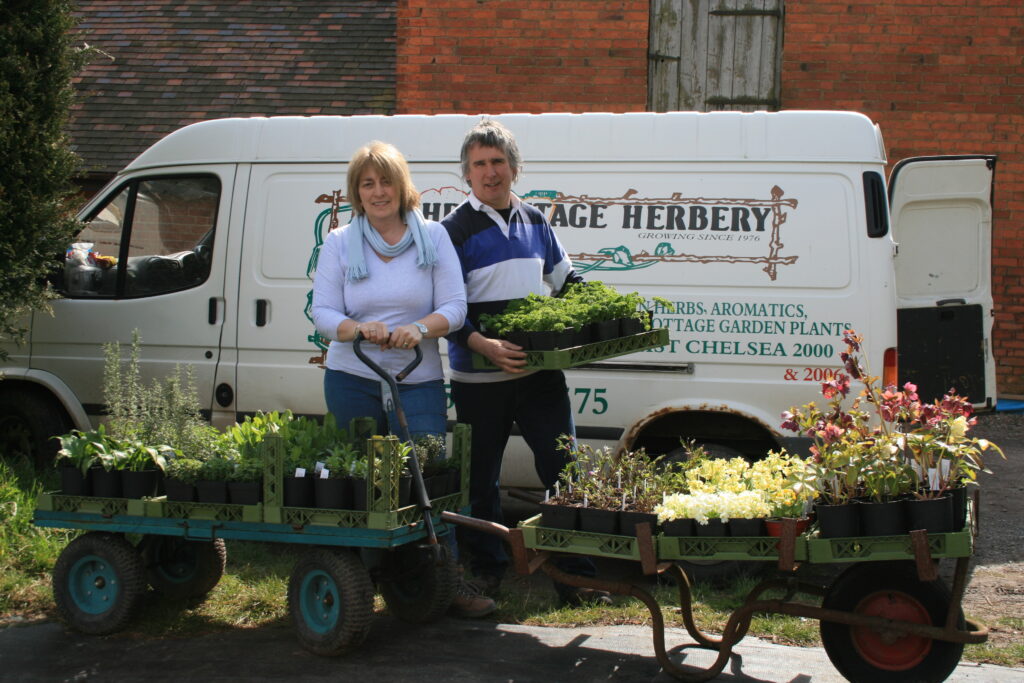
Birgitte Kampmann (IG: @mykitchennotes), a wonderful chef from Copenhagen, is the founder and moving force behind this lively culinary platform she calls, The Kitchen Lab (IG: @kitchenlab_ofs). It is a virtual meeting place where she opens her kitchen once a month to invite culinary speakers, food, writers and historians, and in the most recent session horticulturists and plantswomen.
Birgitte trained at New York City’s French Culinary Institute 20 years ago. When she returned to Denmark she worked as a private chef for 12 years for the Deputy Chief of Mission at the US Embassy in Copenhagen. Later she wrote a cookbook (in Danish), My American Kitchen Notes, and started her own small catering firm, specialising in events for the fashion industry.
She is passionate about food quality and craftsmanship and promoting women in the restaurant industry and is a member of several groups that promote these causes, such as Cherrybombe NYC, Parabere, Danske Madpublicister (Danish Food Writers’ Association), Freja Symposium, and Slow Food. Birgitte also believes in using food as a vehicle for cultural exchange and has practiced this idea through her course “Mad og Kultur i Køkkenet” (Food and Culture in the Kitchen) to a participant mix of immigrants and Danish retired persons for the City of Ballerup.
Kim and I highlighted mint in the May session while another OFS symposiast and writer, Frances Rubin, shared her interest in and passion for watercress.
The evening started in style with a Mojito using one of Kim’s mints, “Heminingway’s Mojito’ and a Strawberry and Mint Shrub from Kim. Frances then put watercress growing in the UK into its historical context.
Mint was the first herb I tasted as a child. We had it growing near the outdoor tap, where the soil never dried out and the plant thrived… and mint sauce was probably the first grown-up sauce I was introduced to.
In many Middle Eastern countries mint tea is the way to start and finish the day. I enjoy picking a handful of leaves, to steep in hot water with a slice of lemon, for my first hot drink of the day. So, even if my mint plants in containers appear to be filling all the available space, I will always try to keep some growing for its hardworking foliage.
Mint is a spreader, effortlessly making new plants wherever its creeping roots take hold, so it is not a herb for a small space. If you can grow it in a large container so you can curtail its spreading habit, it will do well.
It has strongly aromatic leaves and mauve flower spikes in summer. It does best in a moist site in shade but will grow in most conditions. As most mints are invasive, growing them in containers makes sense. Pick leaves when required and before flowering for best flavour. If you want to make new plants take root cuttings or divide plants in spring or autumn. A slip will root quickly in water, and if you want fresh mint in winter, you can force it into leaf in warm conditions in the greenhouse.
Kim offered a nurserywoman’s primer on her top five mints:
- Algerian Tea Mint – as its name suggests it’s a particularly good tea mint, having a clear sweet mint flavour and subtle aroma. It is delicious and soothing.
- Chocolate Peppermint compliments all things chocolate, cake, desserts, ice cream etc.
- Grapefruit Mint is Kim’s favourite, thinly shredded into a bowl of fresh fruits and is a must for fruit sorbets.
- Grannies Mint is The Cottage Herbery’s own mint, well actually Rob’s maternal grandmother’s garden mint – one for that traditional mint sauce.
- Tashkent Mint is a strident high-flavoured good all-rounder.
Kim suggests that if you want just one mint to do the job of making a good mojito, mint sauce, popping into new potatoes or adding to salads then Tashkent ticks all the boxes.
She also showed us how to rejuvenate a mint that was growing out to the edges of its container. I am going to refresh a number of mints this month, tipping them out of their pots, dividing them and turning them round so those shoots that were on the outer rim will be in the middle of the pot. Then I will add some fresh compost, and a little nutrient. Kim uses organic pelleted feed called 5F’s which can be purchased from Fertile Fibre. She also makes her own liquid feed from comfrey, nettles and seaweed extract which is diluted according to need.
Mint is something I always associate served as mint sauce with roast lamb, but you can use it to flavour new peas, new potatoes, in sweet dishes as a syrup or, as a garnish, with strawberries. Its also good with chocolate and to flavour ice cream and sweets.
For the Kitchen Lab session on mint and watercress Birgitte asked us to provide some special recipes and I offered my gran’s mint sauce.
Gran’s Mint Sauce
I remember mint sauce as one of the highlights of a Sunday roast when I was growing up. I loved it when we had roast lamb or what I used to call ‘mutton’ meat.
My Scottish grandmother used to make it when she stayed with us and of course she had taught my mother to make it and I learned it from them.
I haven’t thought about it for a long time… so for this session of Kitchen Lab I put my thinking cap on. Mint sauce is very simple to make… and yet when I looked online just to check the basics I found there were choices between castor and granulated sugar, the amount of hot or boiling water, when to pour it onto the mint leaves and the advice to use white wine vinegar. And also whether to let the sauce stand for more than an hour to allow the flavour to develop. My remembrance was that there was just a short time from making to using…
It was always bound up with the call to collect mint leaves, and use some of the vegetable water. I remember it as a very simple thing: a good quantity of mint, finely chopped, a couple of teaspoons of granulated sugar, the hot vegetable water and then the vinegar. So I made some using ‘Brundall Mint’, which is said to be the true mint sauce mint… and white wine vinegar…. And it didn’t taste like the mint sauce of my memory…. So I thought about the vinegar and realised that in the 1950s in South Africa it was probably unlikely that my mother (and gran in the 1920s) had white wine vinegar. Malt vinegar, which most recipes today say shouldn’t be used for mint sauce, was probably the vinegar of choice…
So I tried it again…. And it was as I remembered. So there you are: memory and imagination in a simple sauce. Kim had suggested I use one of her mints, ‘Grannies’ which was one that she and her husband Rob had rescued from his grandmother’s garden. That seemed to be the one and its taste, brought back those minty memories. Kim also suggests Tashkent and Nile.
The ingredients for my Gran’s Mint Sauce in my memory are:
- a good bunch of mint, chopped
- 2 tbsp boiling water
- 2 tbsp malt vinegar
- I tsp granulated sugar
I use sharp scissors to chop the mint, but in making this version I also followed one suggestion from a modern recipe to sprinkle the sugar over the mint leaves before you cut them, using a sharp knife to cut the sugared leaves. It is a good way to combine these two ingredients. And that got me thinking about mint sugar…. Another day maybe!
Then the boiled water and finally the malt vinegar. I left the mix to stand for about 10 minutes, stirring it well before letting it stand.
And then serving it with the lamb…
You can add ingredients to taste, and the quantity of mint can be greatly increased for a very pungent sauce.
Just the other day, though, I read another version of mint sauce (yes I am getting a bit obsessed). This was from Mellie Uyldert (1908-2009), described as a Dutch New Age writer, who used brown sugar, suggested leaving the sugar and mint leaves to stand for 20 minutes and omitting the hot water, poured half a cup of vinegar over the mint and sugar.
Kim’s recipe for a Pearl Barley and Mint Salad served with Birgitte’s Minty Yogurt Dip was a delicious main course, and then there were The Cottage Herbery’s ‘to swoon for’ Chocolate Dipped Mint Leaves.
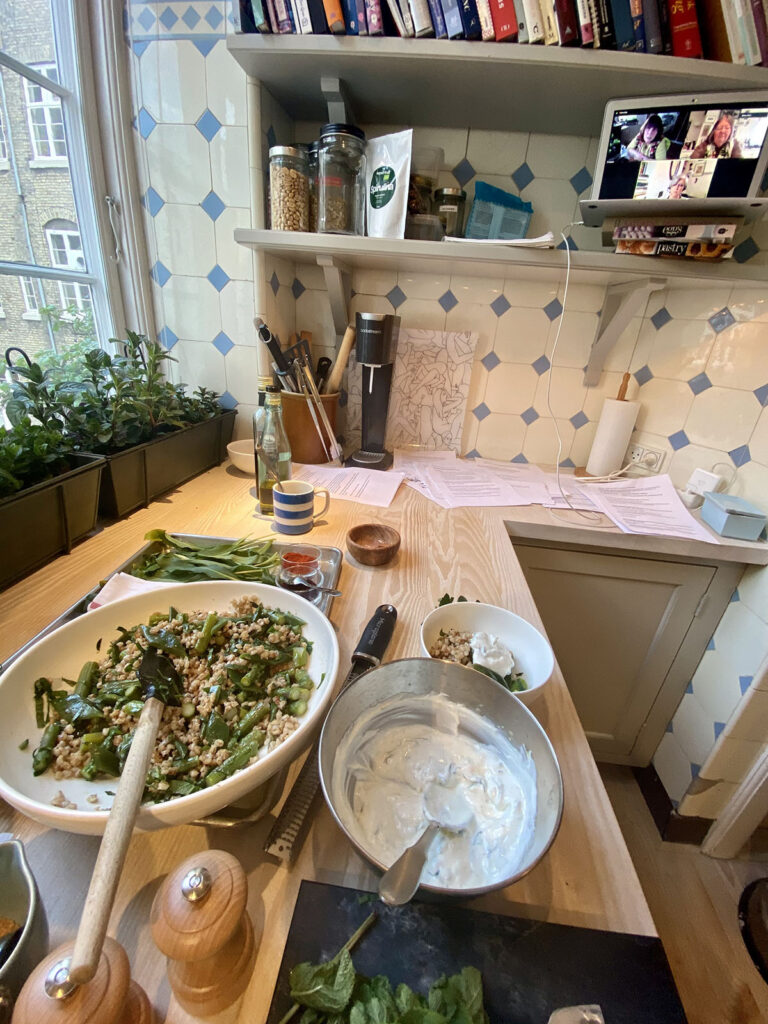
Birgitte’s studio in her kitchen set up for the Kitchen Lab event. 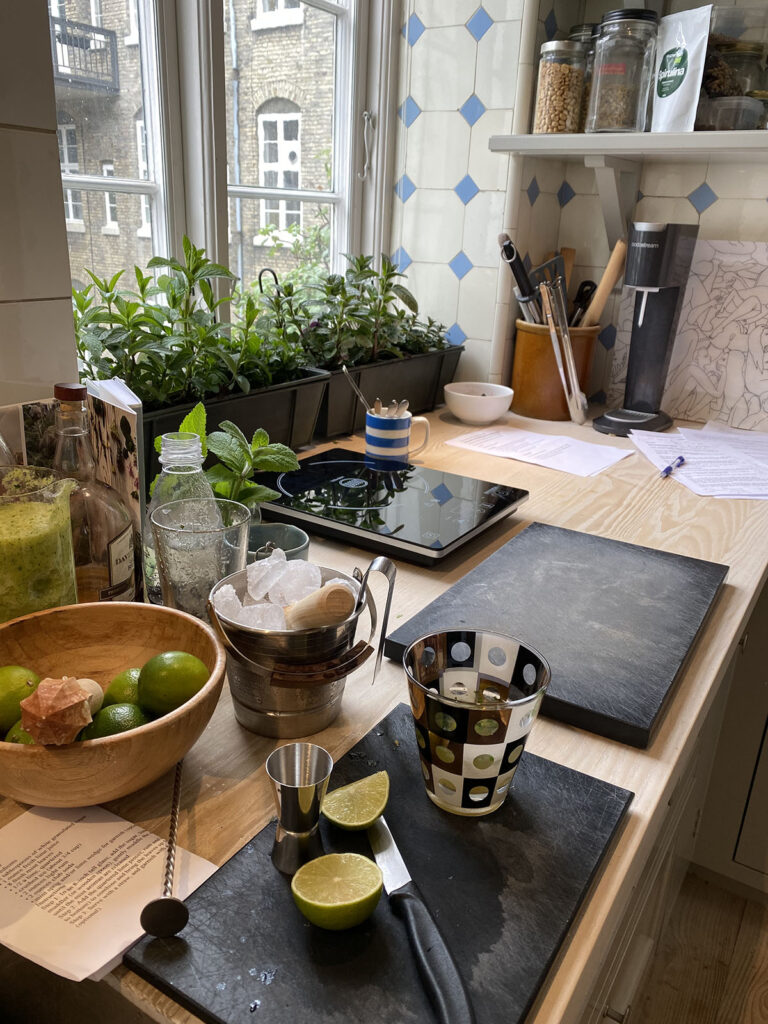
Birgitte set up for making a mojito.
Species
Different mints have different flavours and uses, and because of the range of variegation in mint leaves and attractive flowers, it is versatile in the garden. Moroccan spearmint (Mentha spicata) is used as a tea or tisane. Creeping pennyroyal (Mentha pulegium), with bright green leaves is used as an insect repellent to deter ants and fleas.
Applemint (Mentha suaveolens) with furry leaves has an apple flavour. Also attractive in salads is variegated apple mint or pineapple mint, Mentha suaveolens ‘Variegata’. Lemon mint (Mentha piperita f. citrata ‘Lemon’) has pale green lemon-scented leaves, and is useful with chicken, fish and fruit dishes. Eau-de-Cologne mint (Mentha x piperita f. citrata) has a perfumed lemon scent and purplish tinged leaves and stems. Ginger mint (Mentha x gracilis ‘Variegata’) has a fruity, ginger flavour and bold, golden splashed leaves.
My favourite mint of all, though, has delicate small leaves and is not invasive at all. ‘Strawberry Mint’ is just that…. it tastes of ripe berries, Summer Pudding, Eton Mess, Pavlovas, cream teas during Wimbledon week and all that….
Text & photos © Barbara Segall 2021 except where noted.
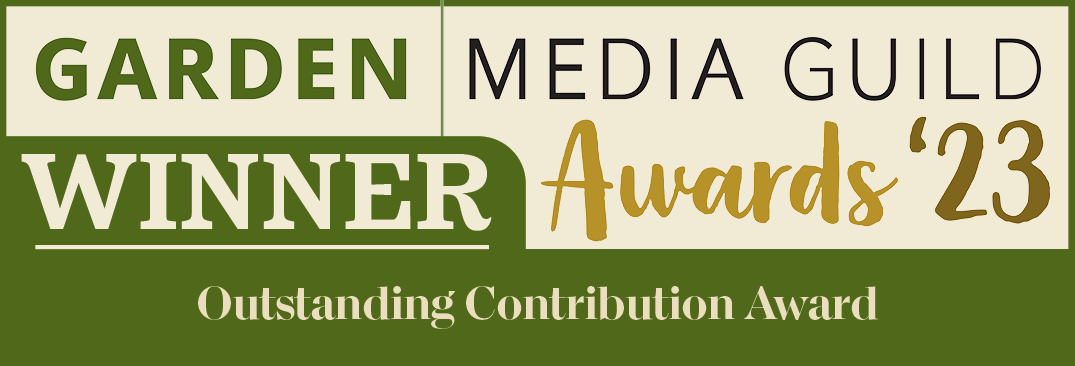


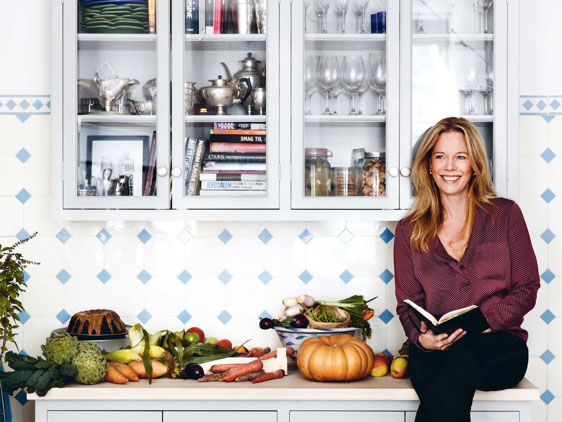
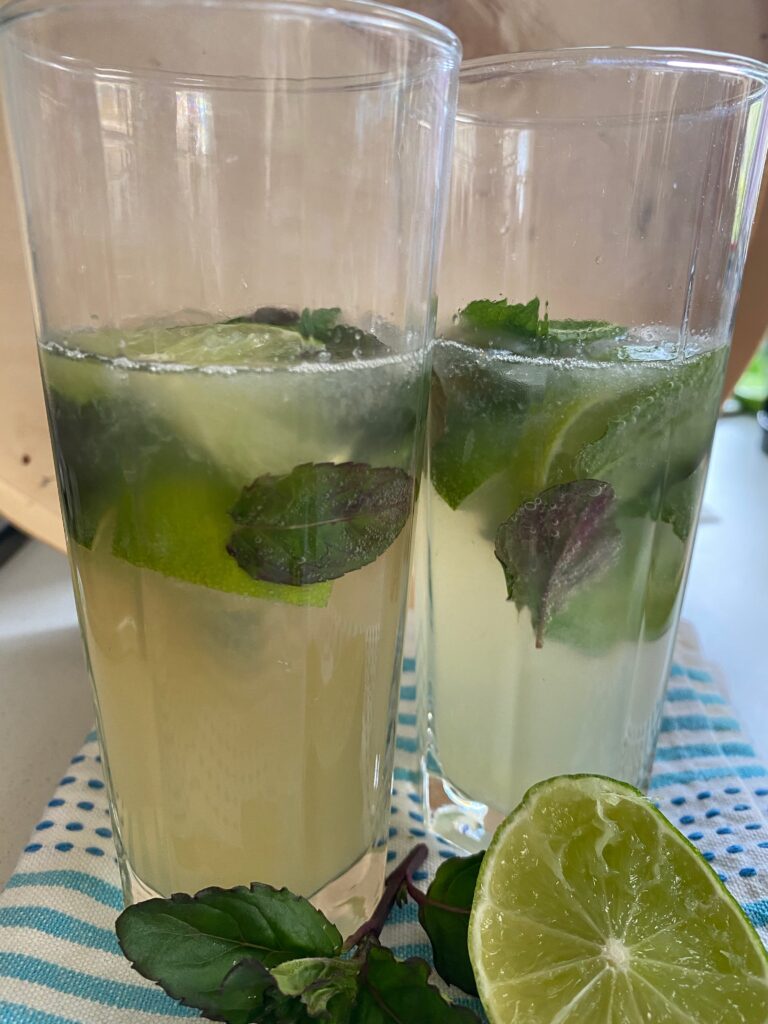
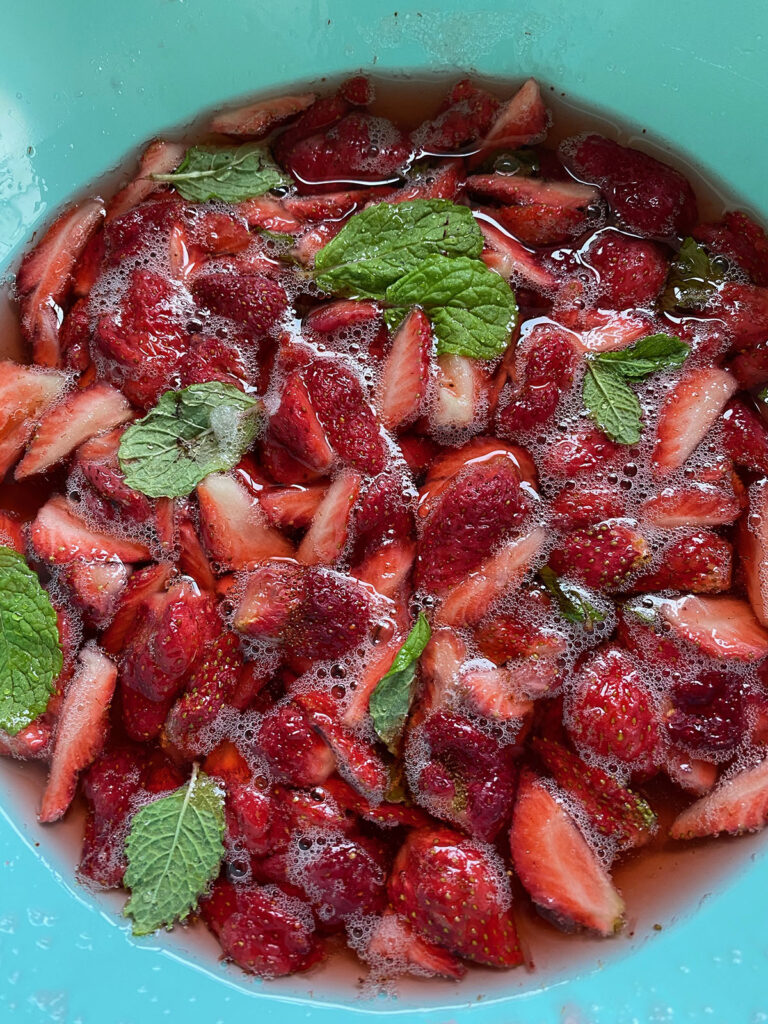
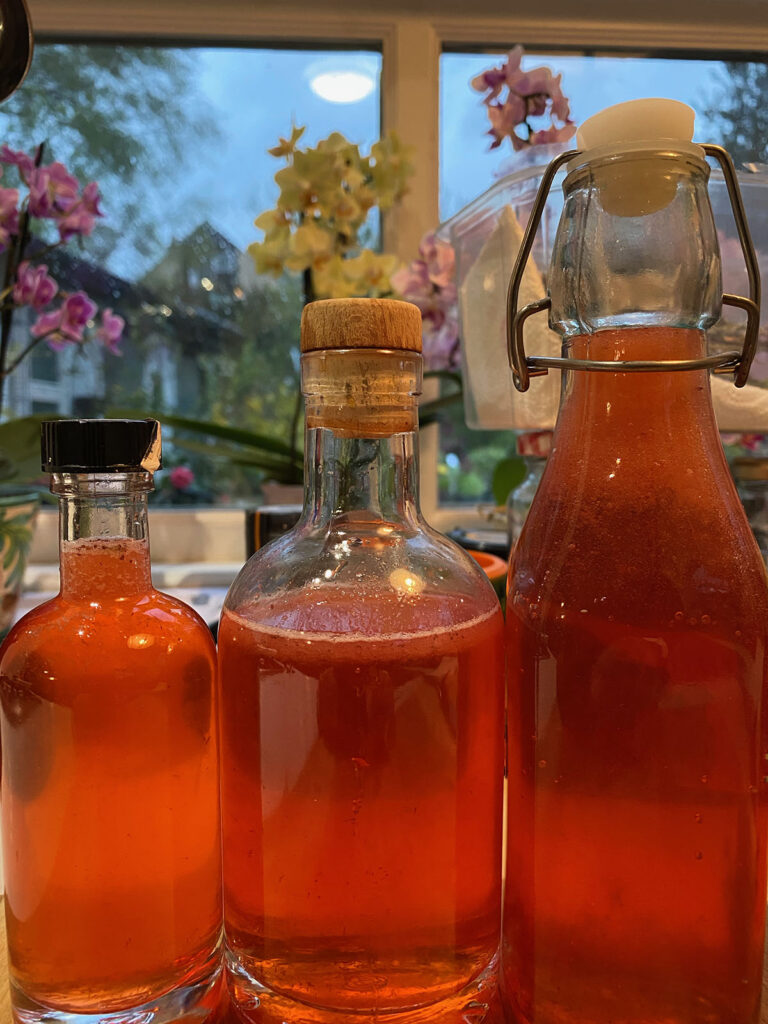
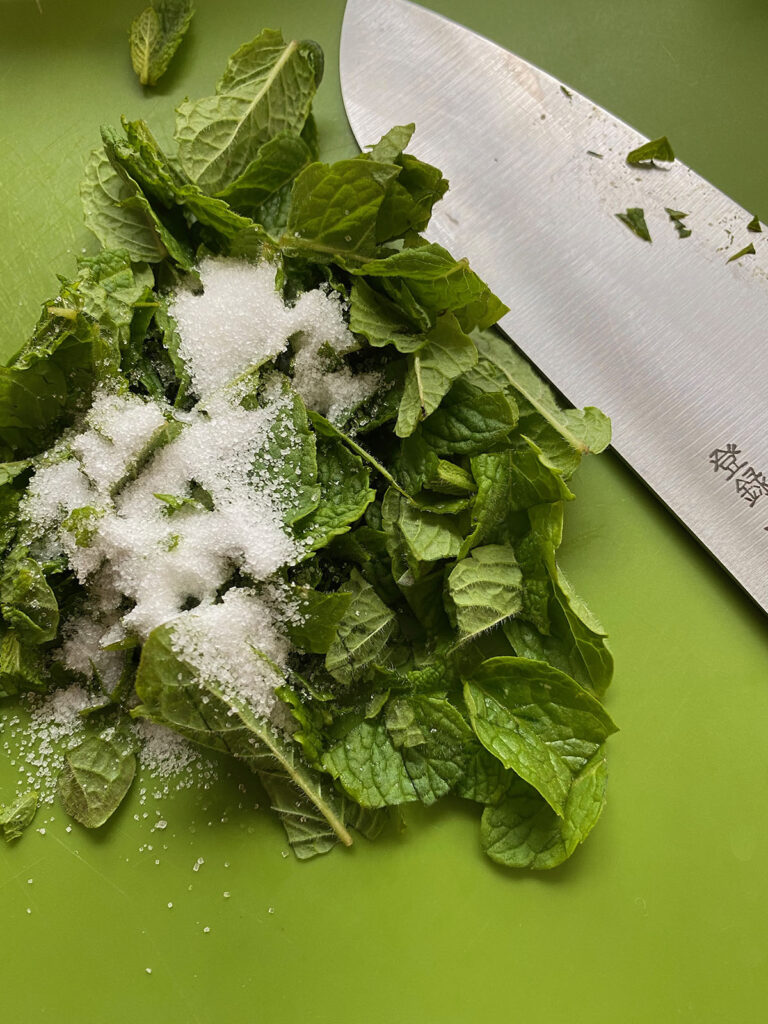
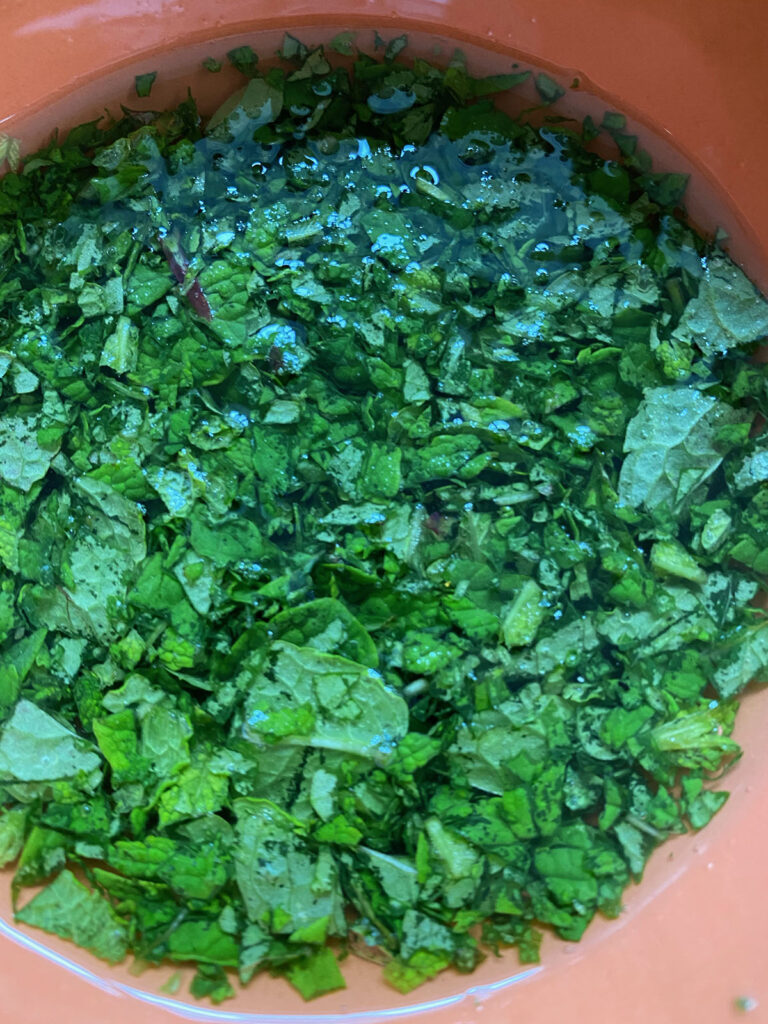
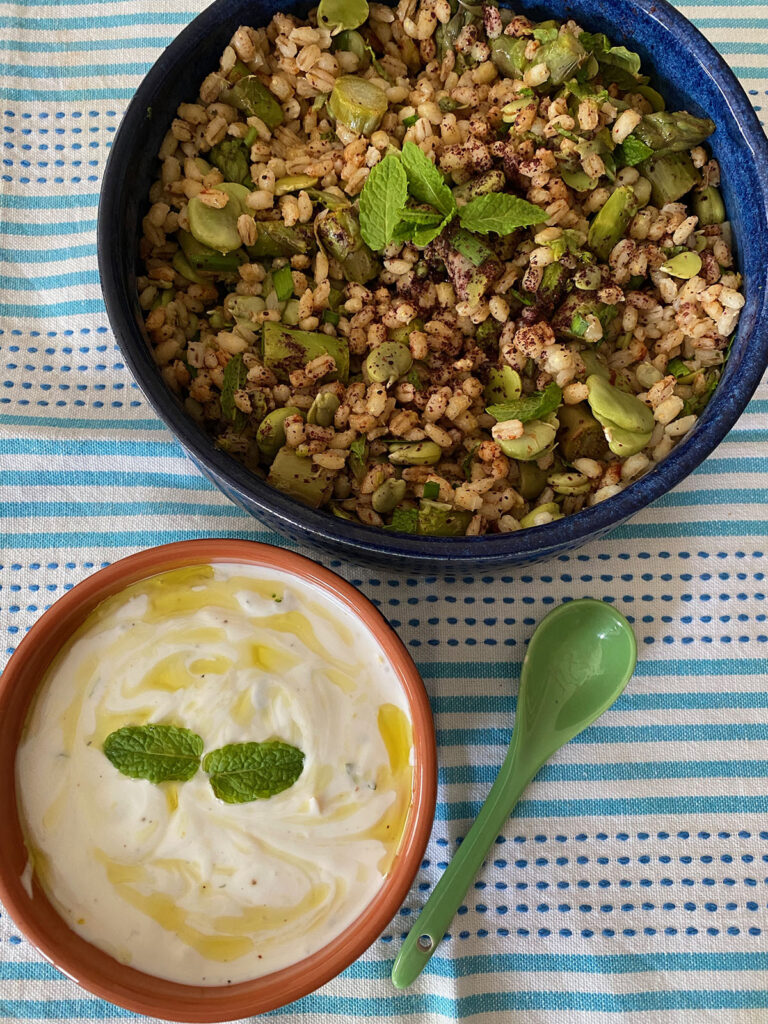
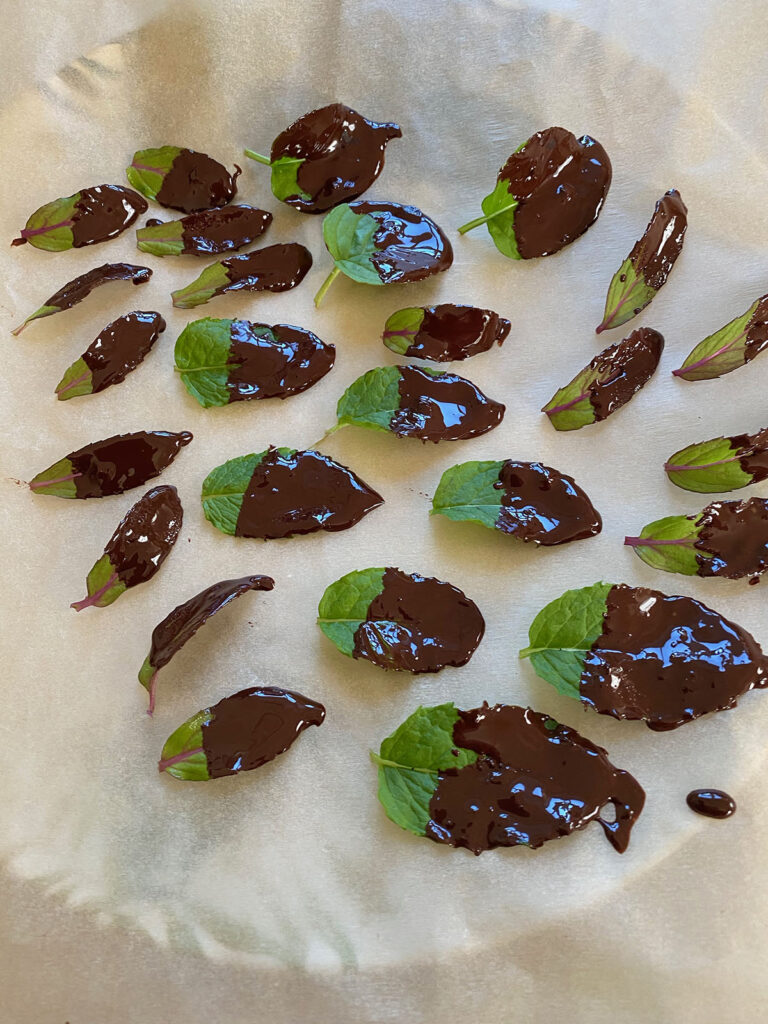
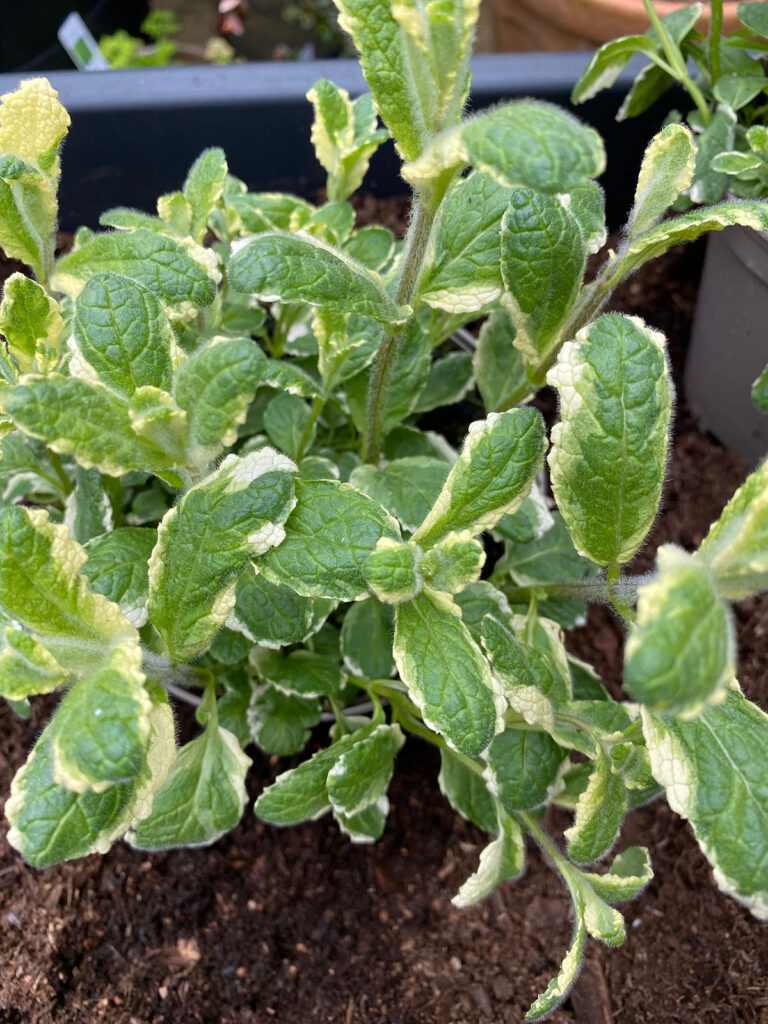
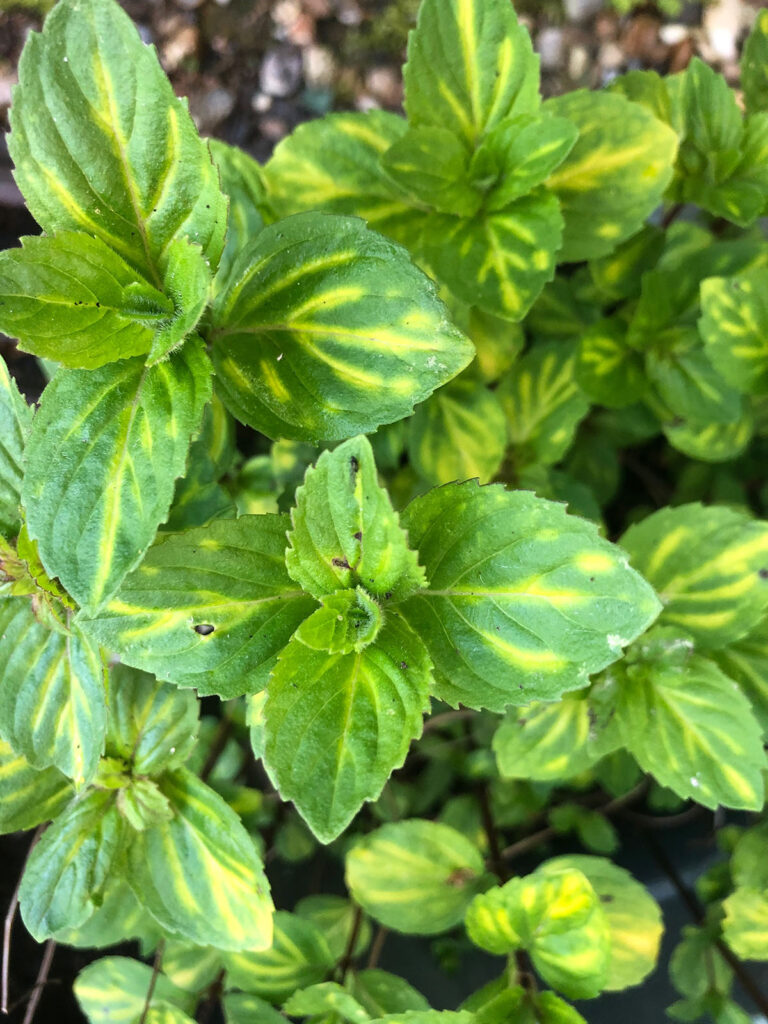
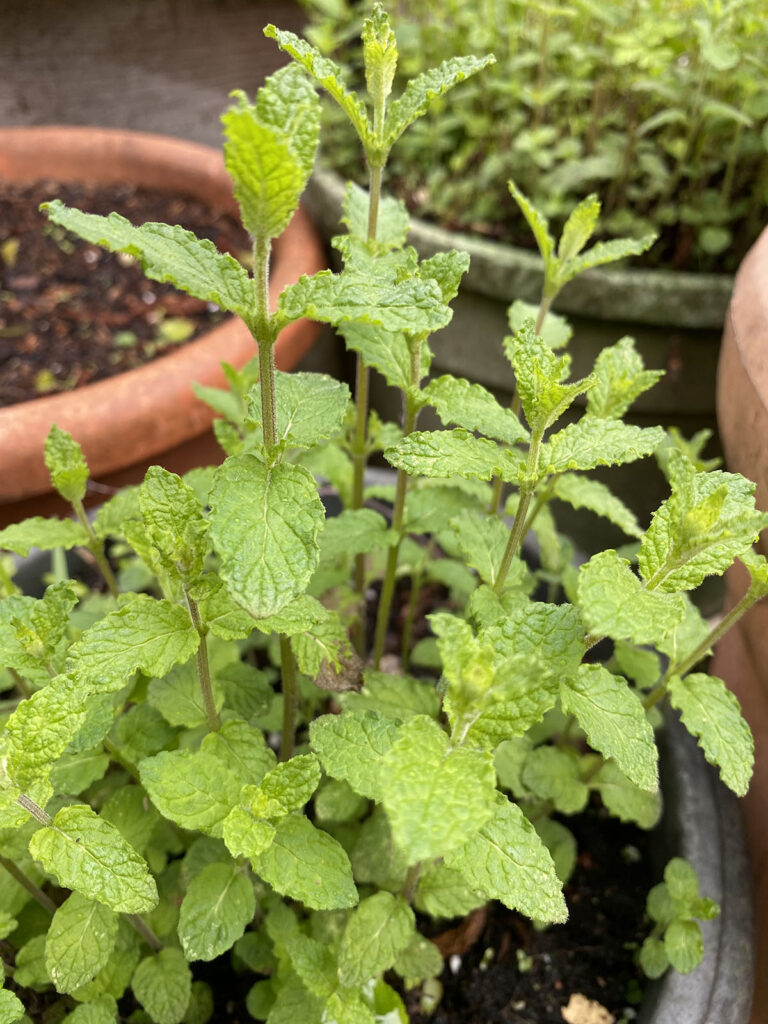
Thank you Barbara for including me in your lovely article about mint – I learned so much. Hope to have you back in the lab teaching us about other herbs ! x